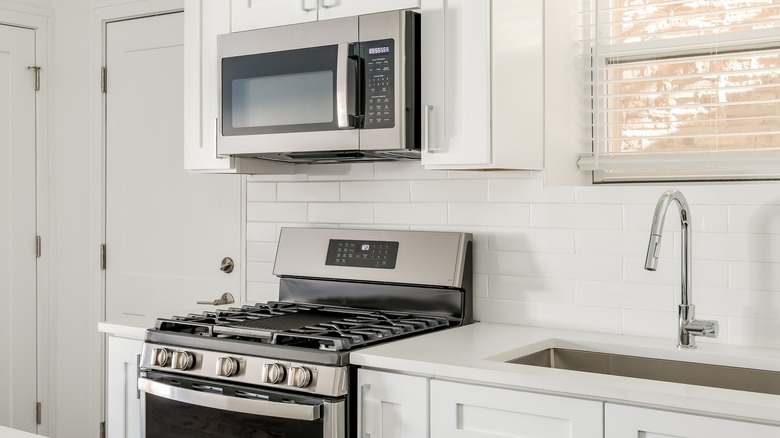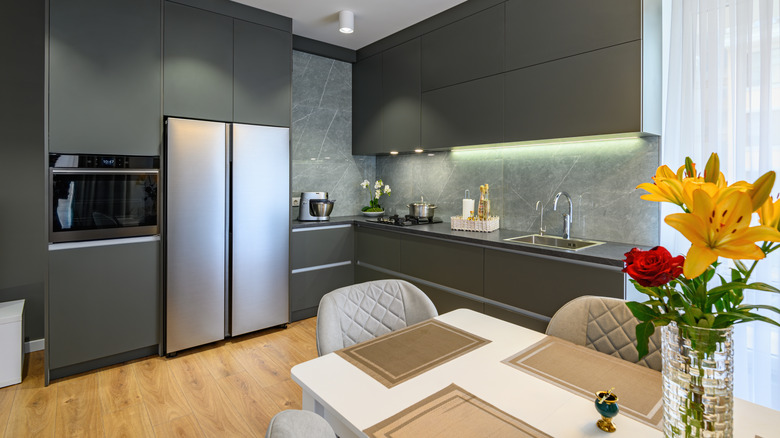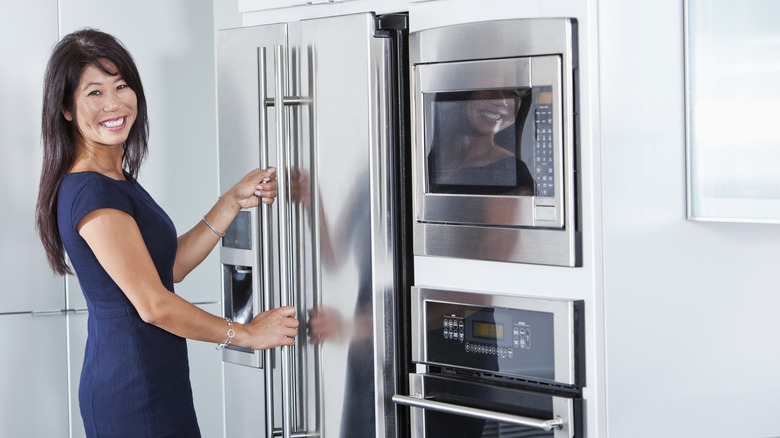An Expert Designer Settles The Debate Between Matte And Shiny Kitchen Appliances
Browsing the appliance store, you come across a fabulous new refrigerator that is exactly what you need, but you have to choose between two models, one with a shiny, more traditional finish and the other with a matte finish. Which one is right for you? Isfira Jensen, the principal designer and CEO of Nufaceet Interiors, shares that matte appliance finishes are quite the contemporary option and offer benefits like not allowing fingerprints to show (via Homes & Gardens). However, you shouldn't rule out shiny appliances, according to Arsight interior designer and founder Artem Kropovinsky, who shares that matte surfaces are harder to clean, though they are excellent at helping to calm spaces down.
While you should choose based on what you like and what aesthetically fits your kitchen space, both options could be a consideration in the modern space. There's no doubt that matte finishes have become a popular trend in many kitchens, but are they the long-lasting look you want? Before you choose, take a closer look at the key differences in these appliances and where they work, based on a few expert designer tips and strategies.
When to choose a matte finish for appliances
Matte finishes have become a luxury, must-have update to many kitchens. They are eye-catching and offer a more subdued look in the kitchen. In some ways, adding a matte finish to your kitchen can help to bring in a modern level of softness. It's still quite sleek in the metal tone and look, but at the same time, it's not bold and bright like a shiny finish.
Kropovinsky shares, "Their upkeep can be challenging compared to shiny finishes," thanks to the small bumps on the surface. They're not smooth enough that you can just wipe them down and remove all of the grease and grime. Rather, the tiny bumps mean you'll need to apply more pressure and a soapy, wet towel to keep them clean.
A big part of the attractiveness of matte appliances, though, is that they don't shine, thanks to the surface absorbing instead of reflecting light. If you want to add a bit more texture to the space and even bring down some of the luster in the kitchen, matte can do that for you. Jensen shares she recommends matte "whenever we are designing a contemporary space. They offer a sleek look with no trace of fingerprints or smudges."
When to choose a shiny surface for appliances
Don't rule out the traditional shiny, stainless-steel finish for your appliances, though. For many people, the biggest drawback of any shiny surface is that it captures the light, allowing anything on the surface, like sticky fingerprints, to show up easily. That may mean wiping them down more often. Yet, as noted by Kropovinsky, that's easy to do with just a quick wipe down and shine.
There are reasons to use shiny surfaces like this in a kitchen. In a smaller kitchen, matte isn't ideal because they create a more prominent feel, a deadening effect, for example. By contrast, when including a shiny appliance in a kitchen, it bounces light around, helping to make the space feel more open and brighter, and that can help a small kitchen feel larger. Stainless steel appliances, a common option in shiny appliances, have a timeless look and blend well with just about any other color in the space. It works well if you have striking black countertops or intricate lined marble while complementing most types of wood tones for cabinetry as well. There's no doubt matte finishes are the "in" choice right now, but they don't offer the flexibility of blending well with every space. Go with shiny appliances when you want a bright, easy-to-accessorize option that's stood the test of time in design.


